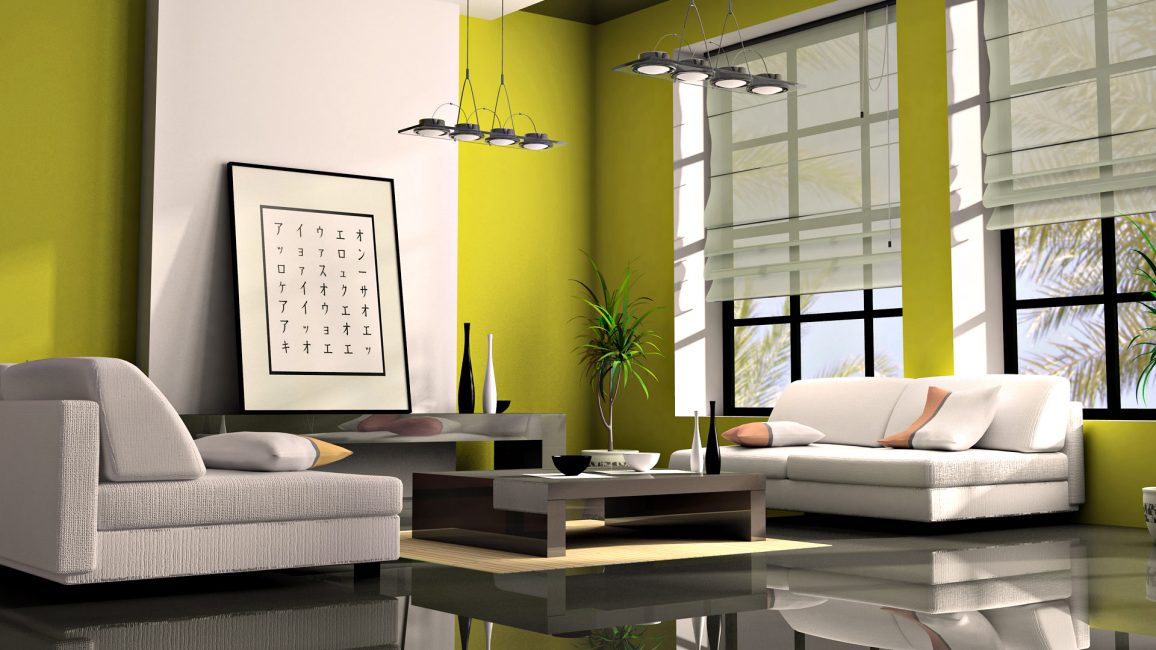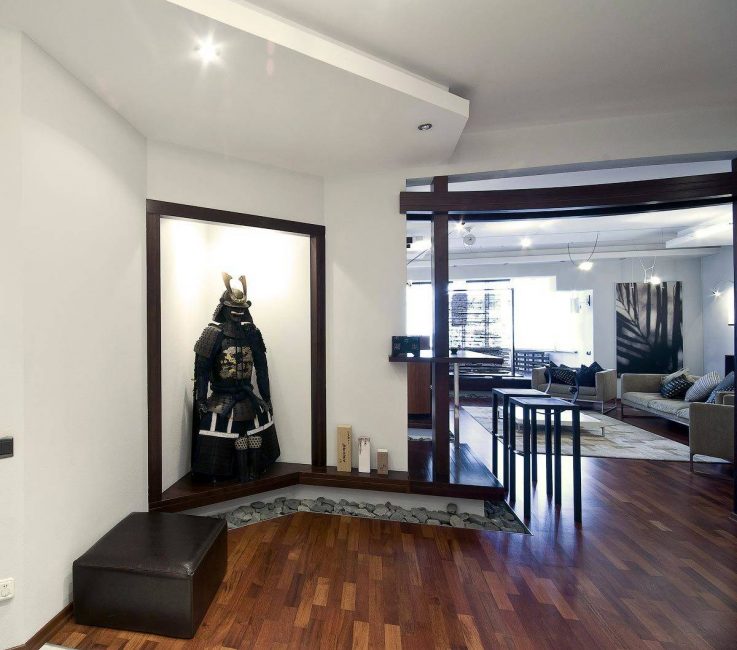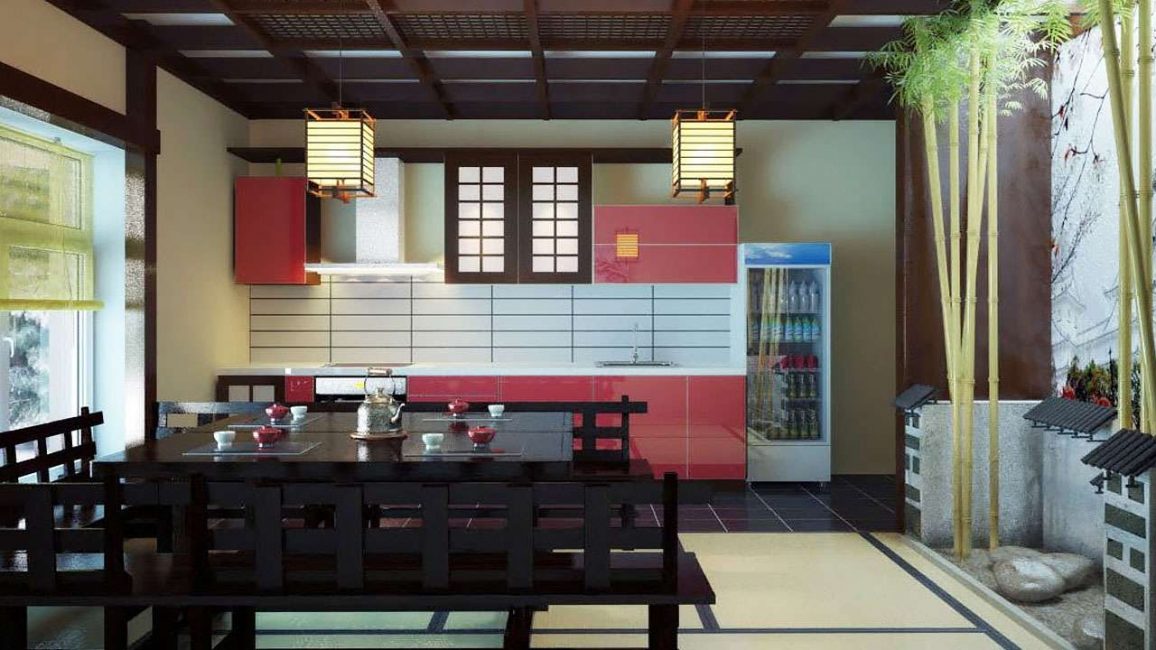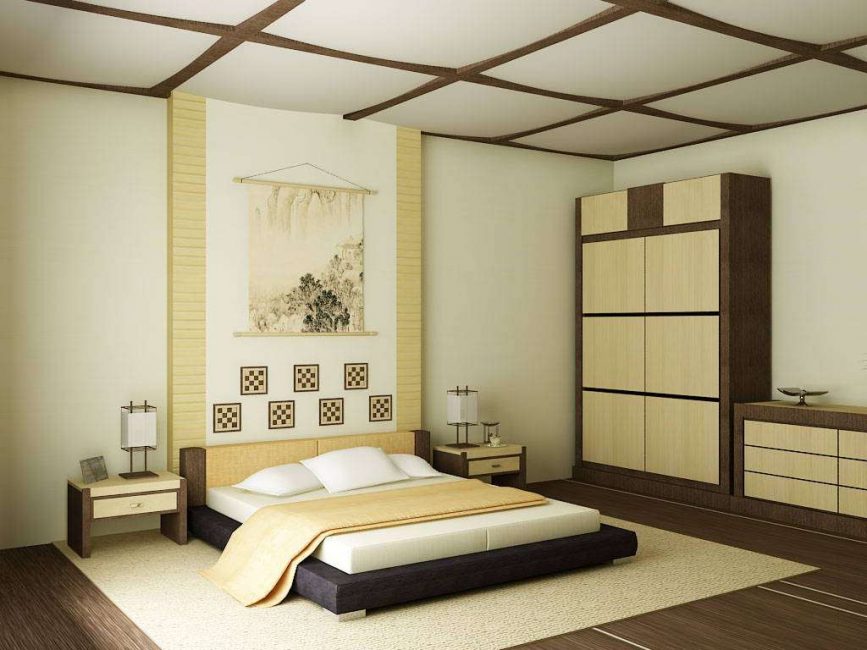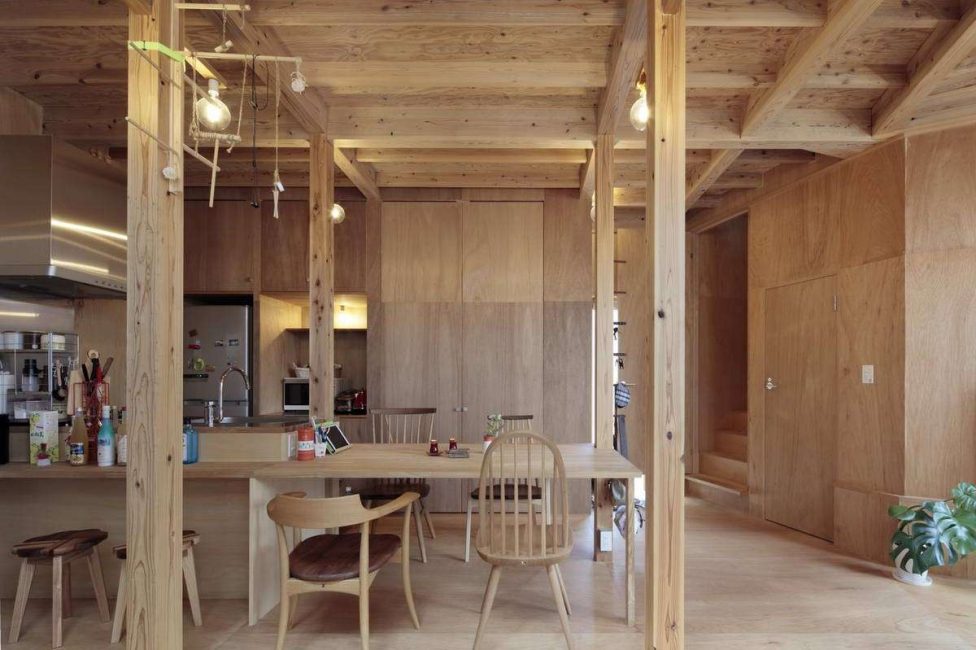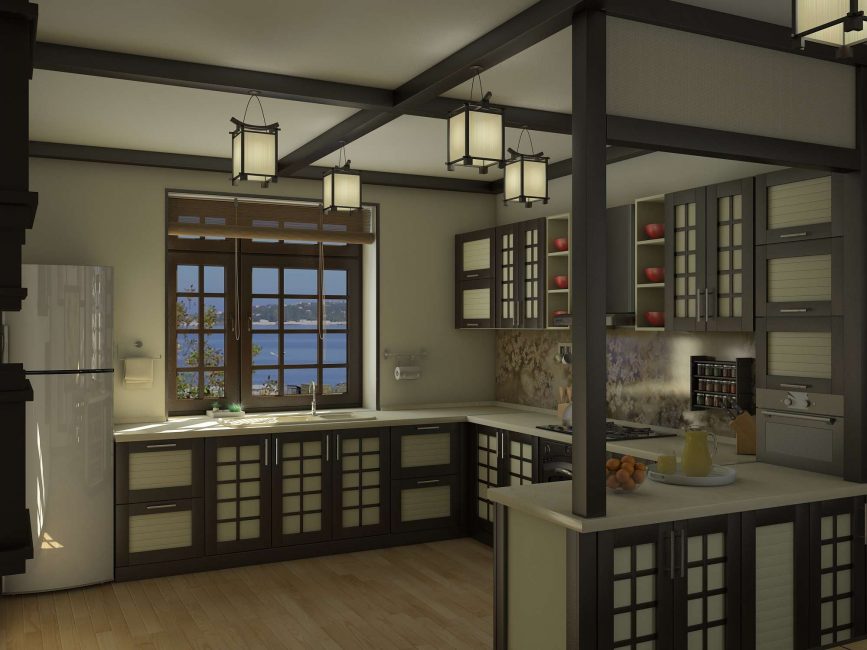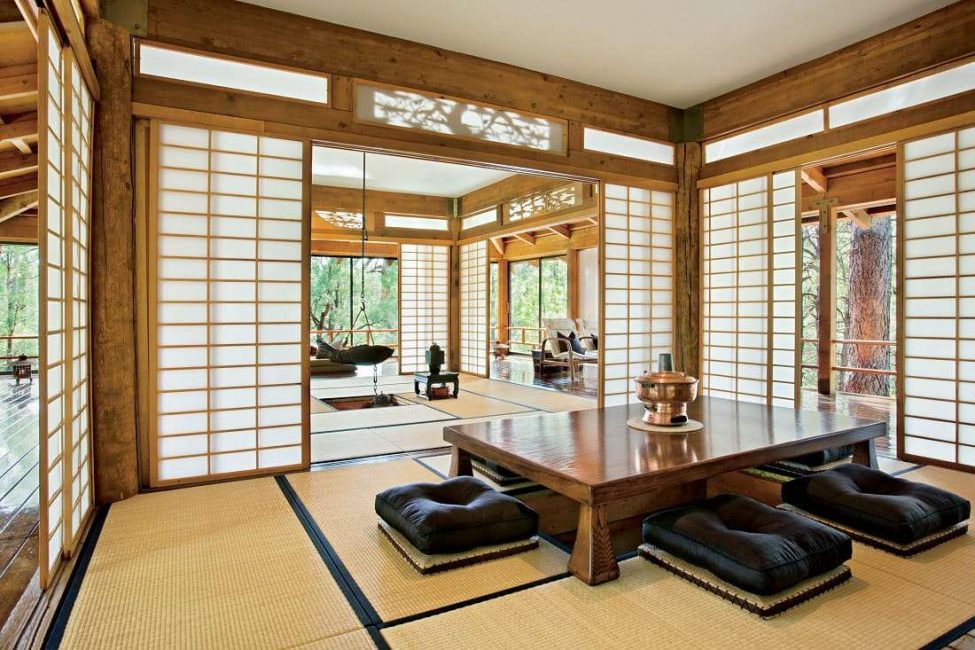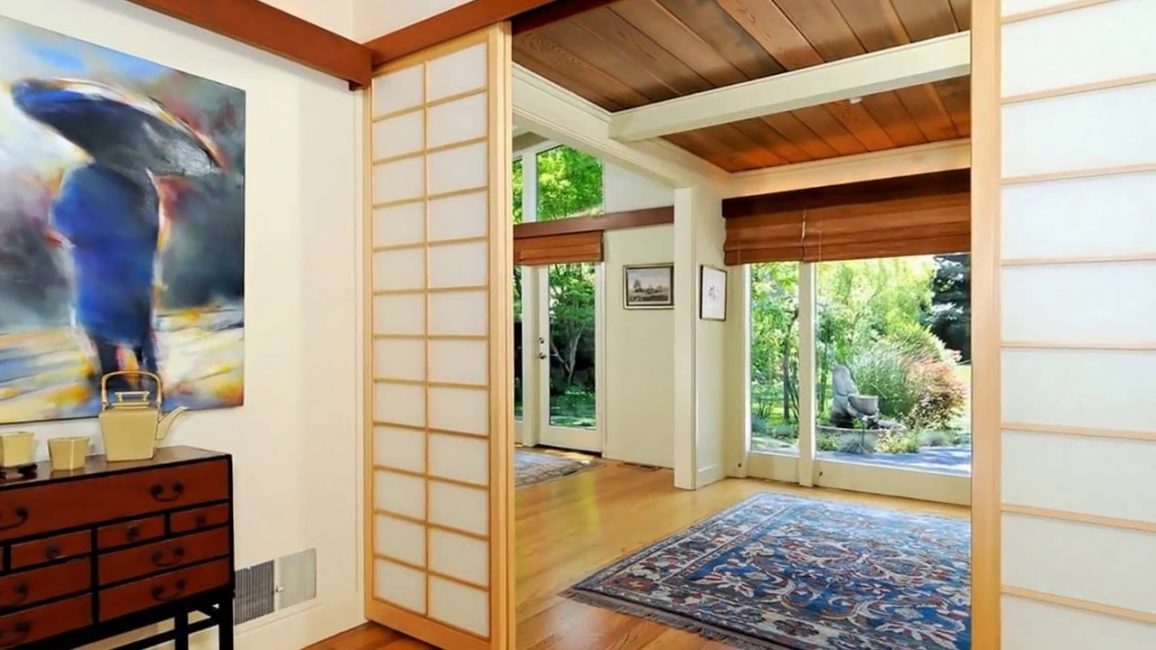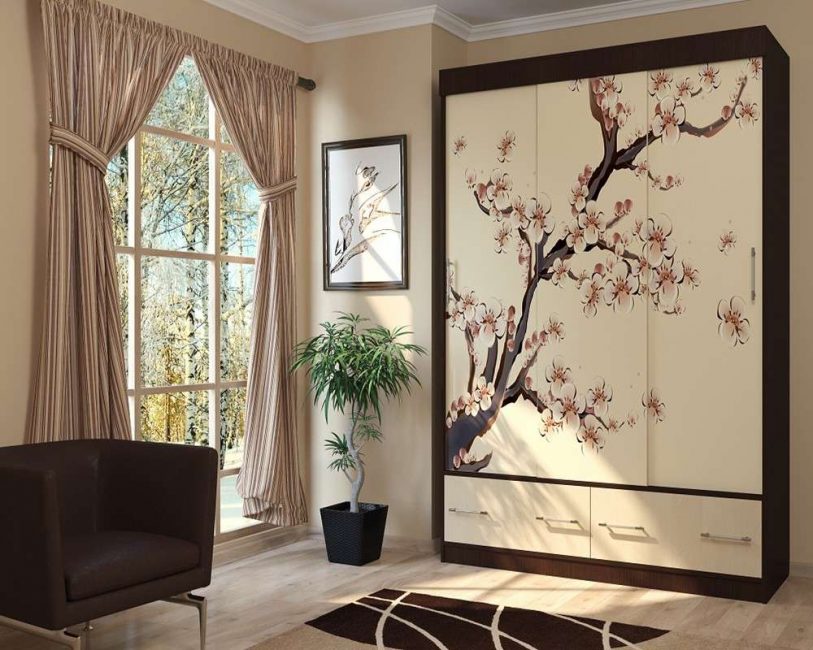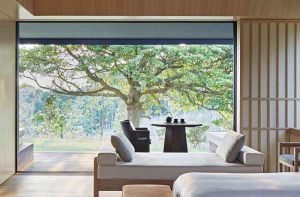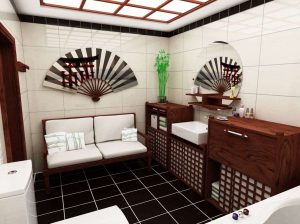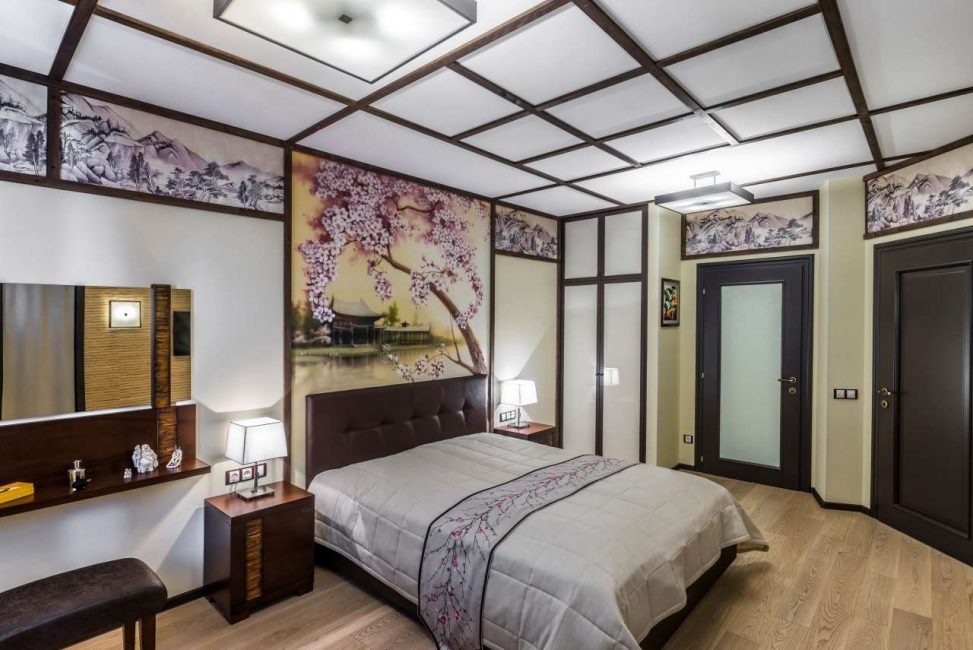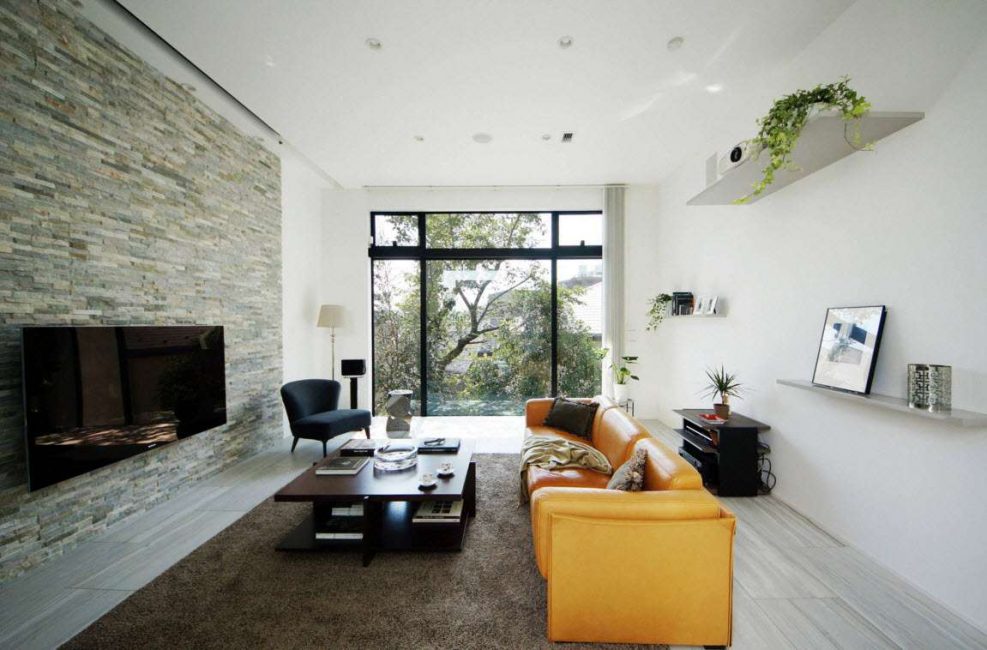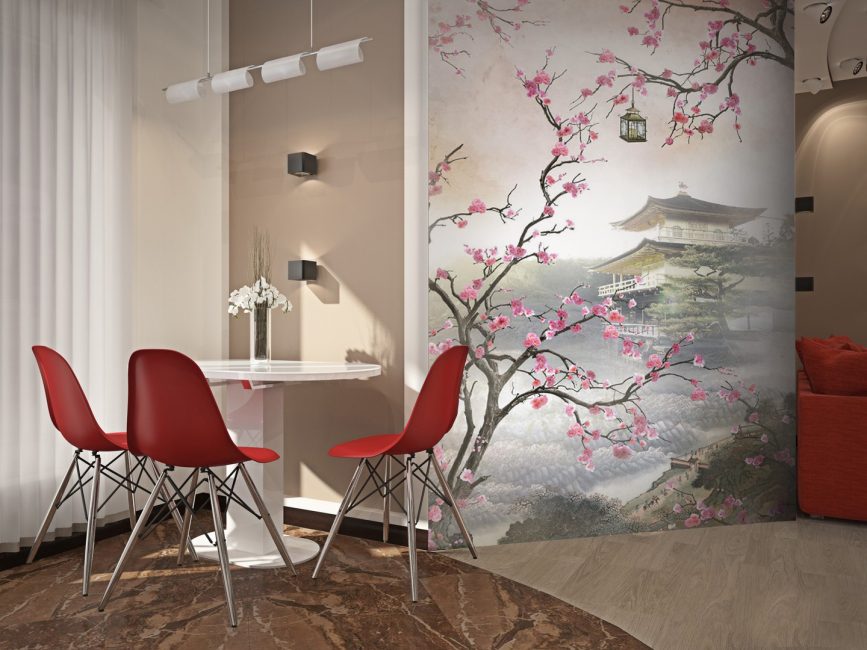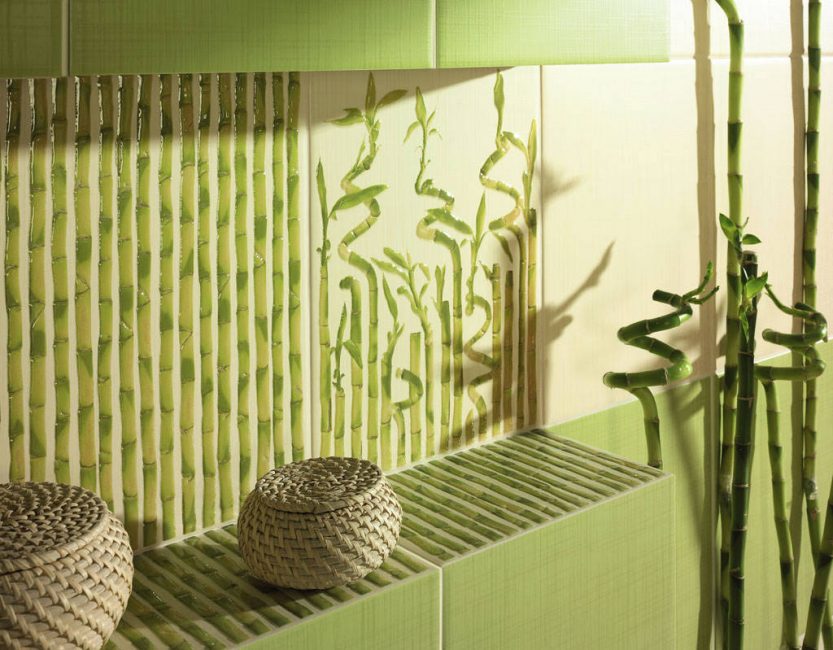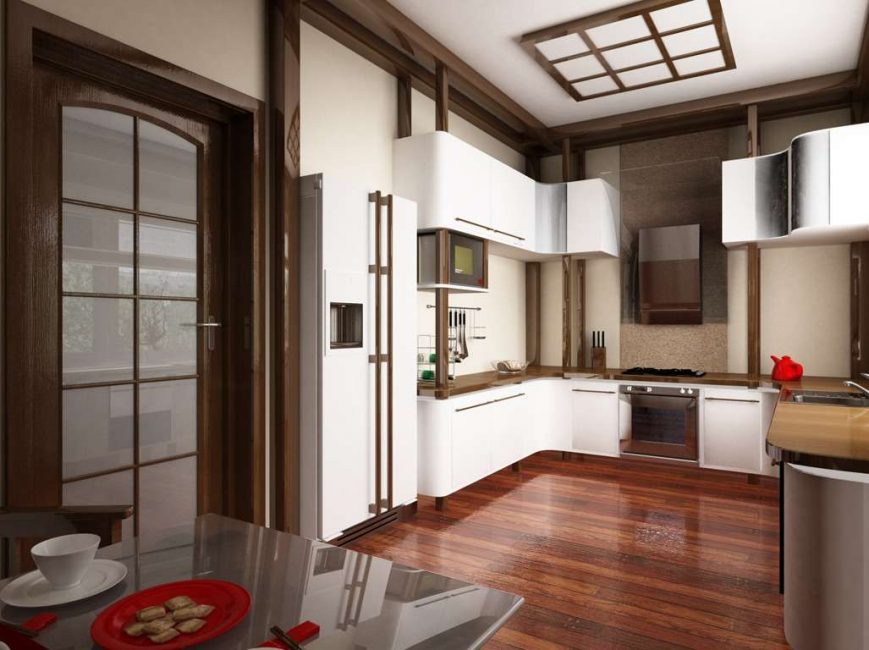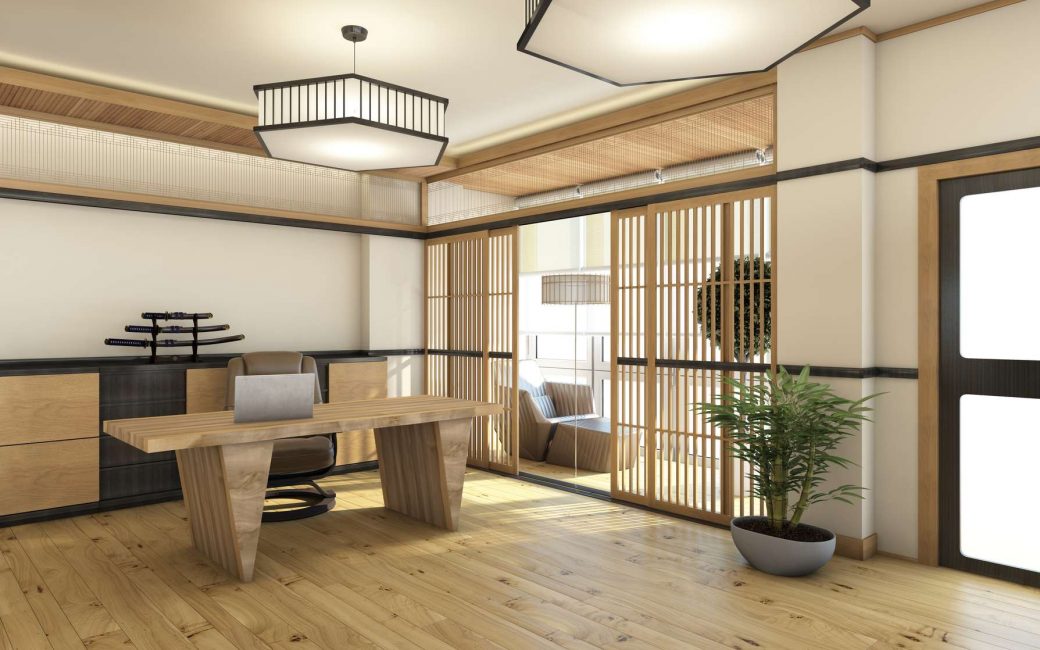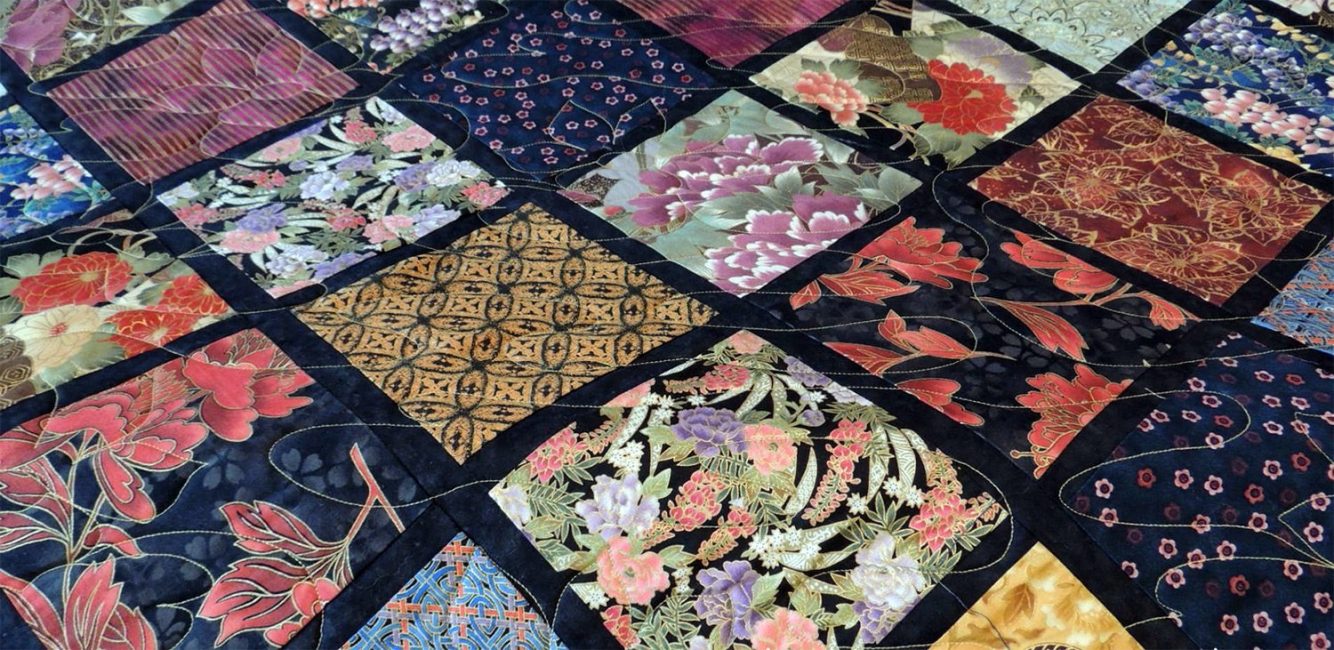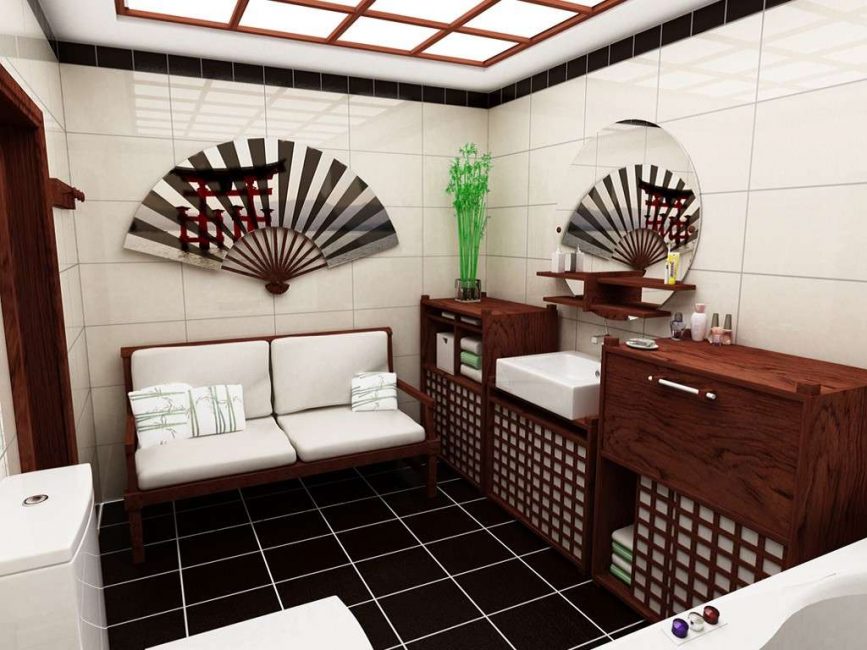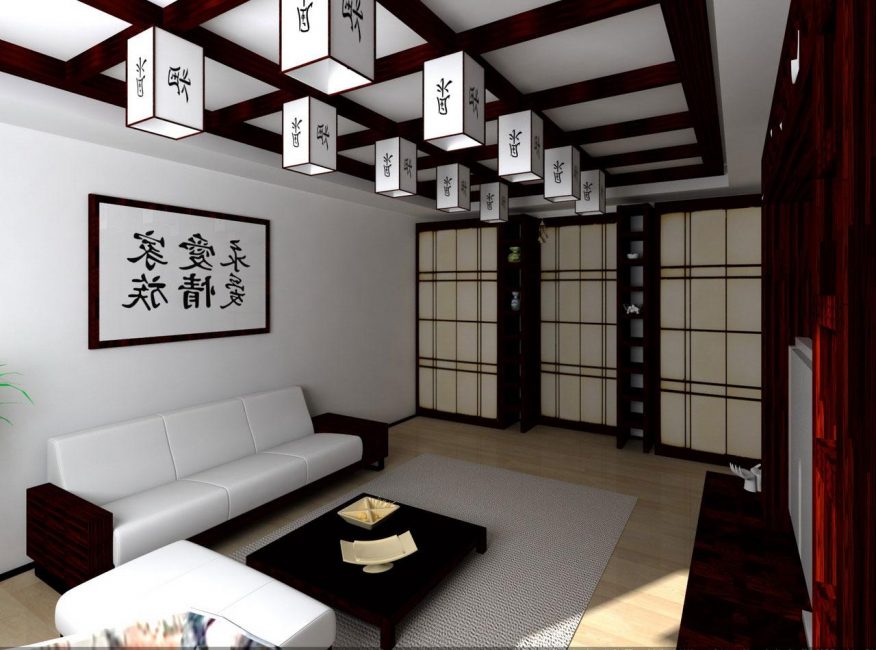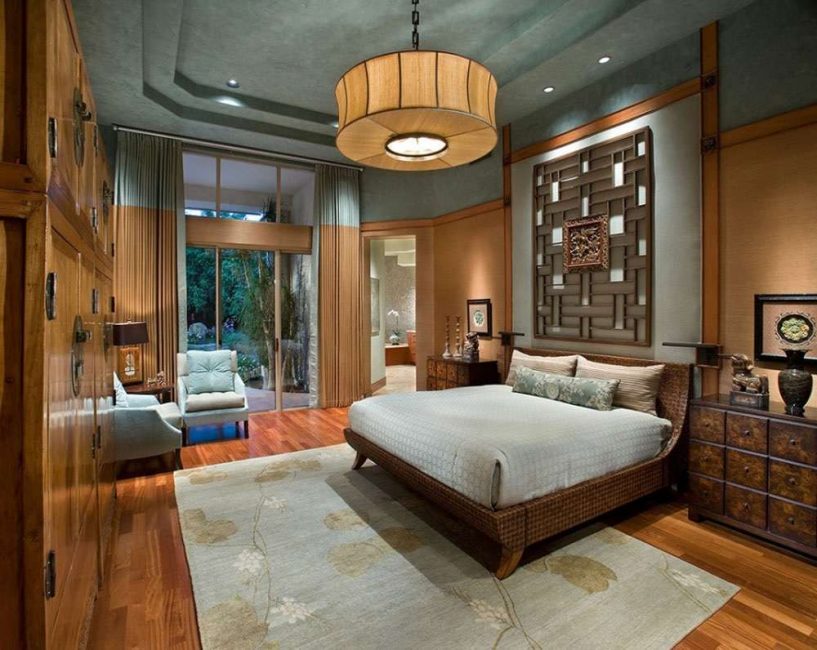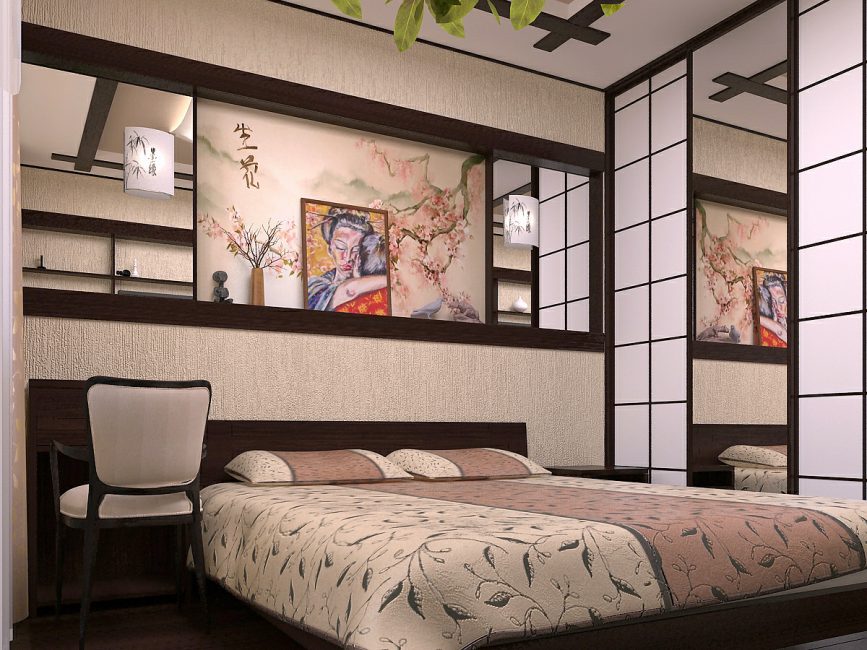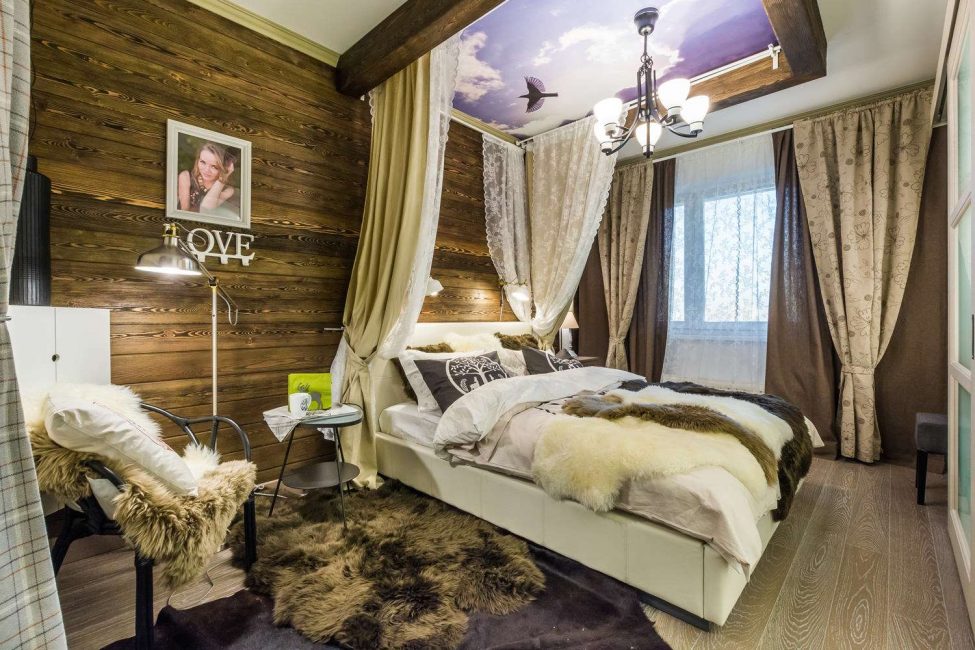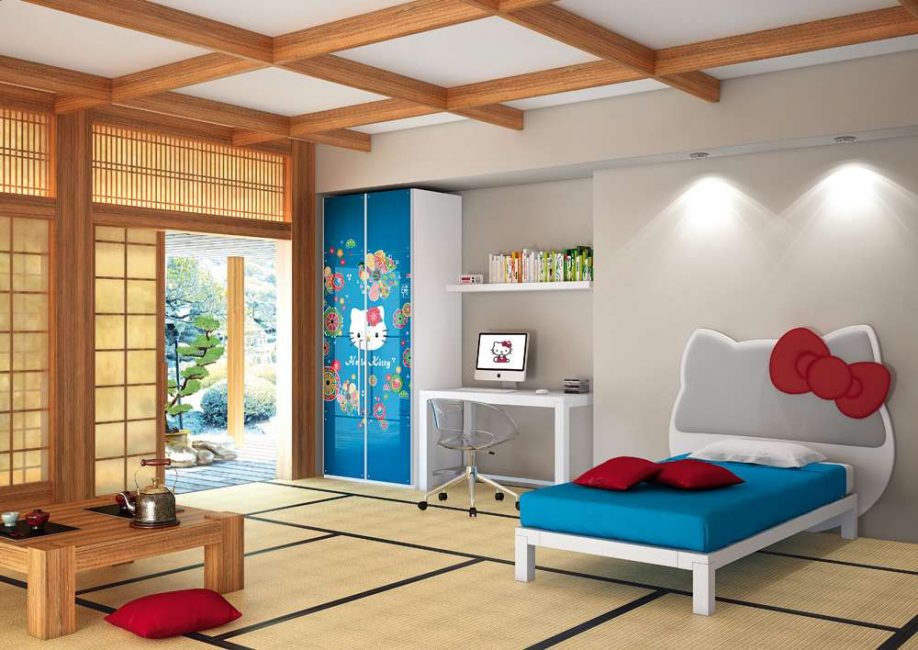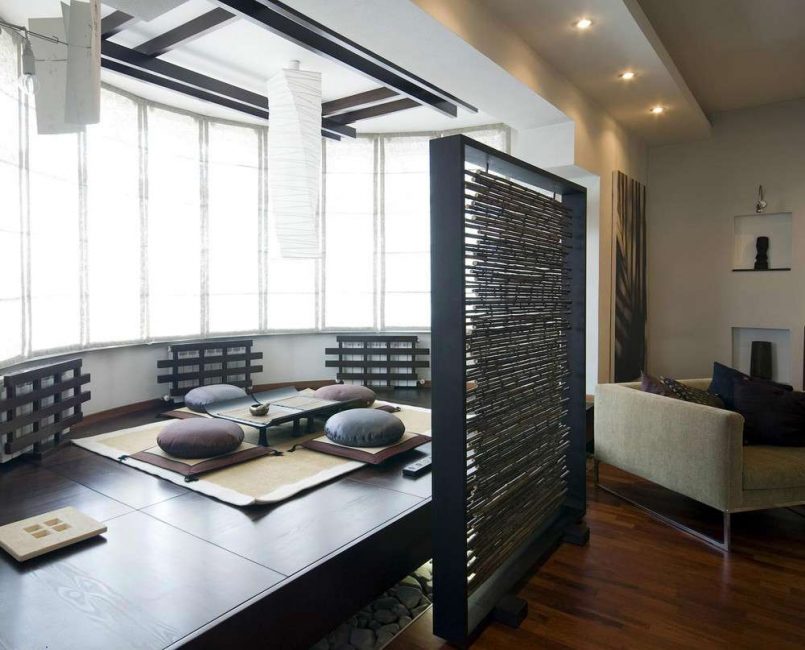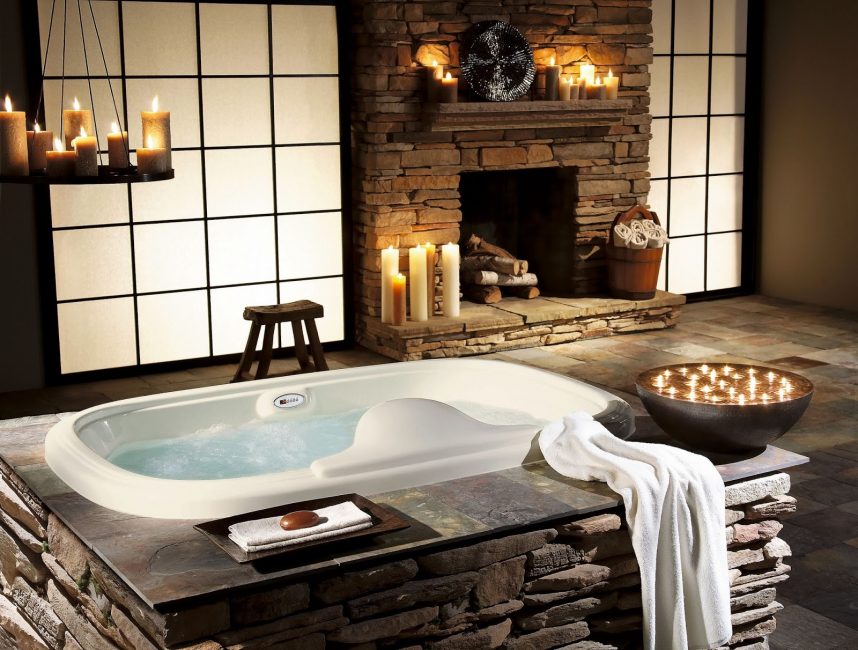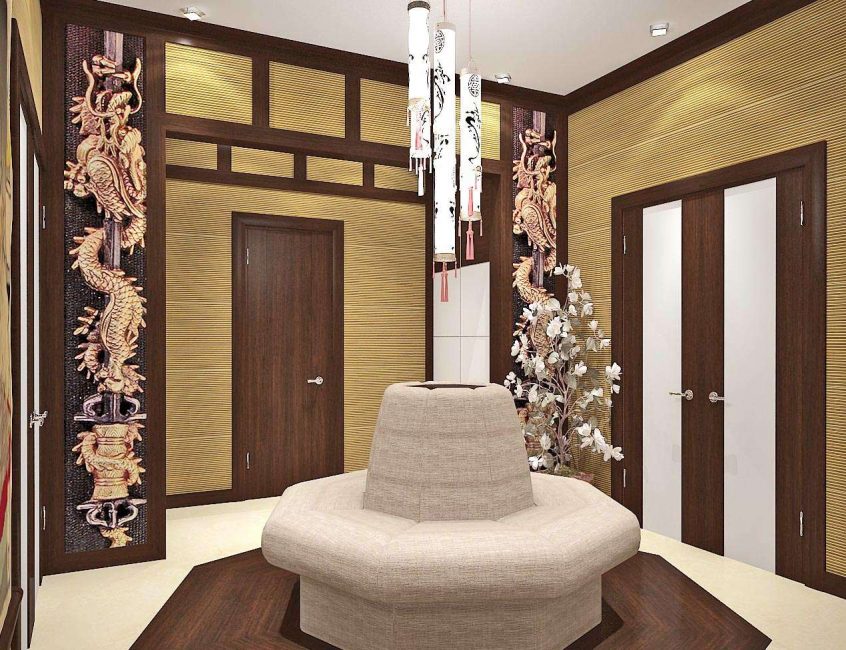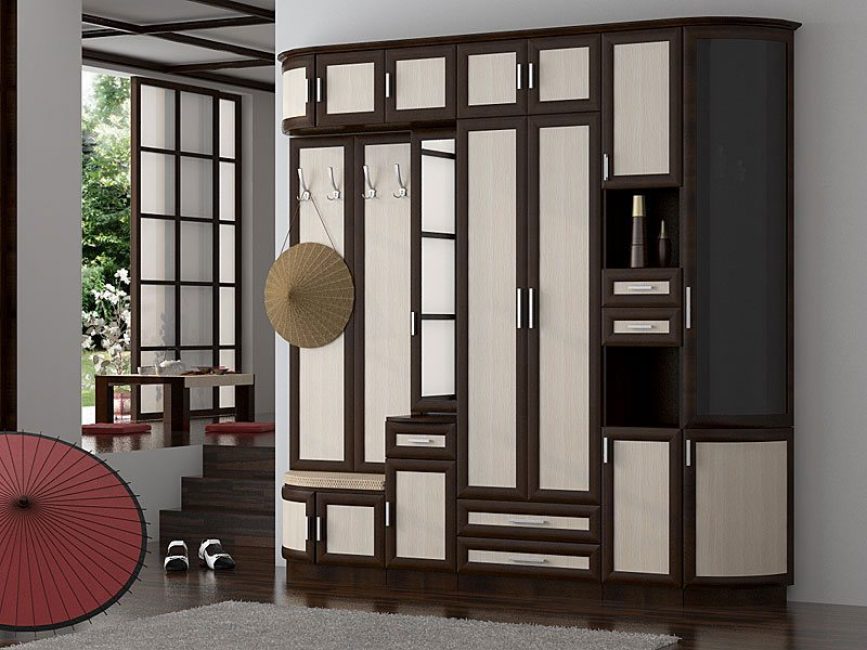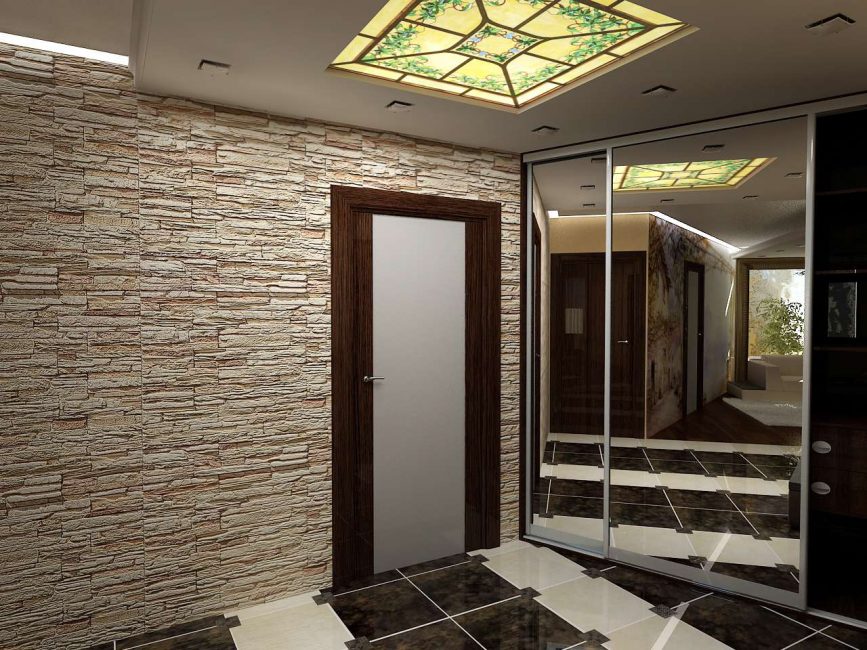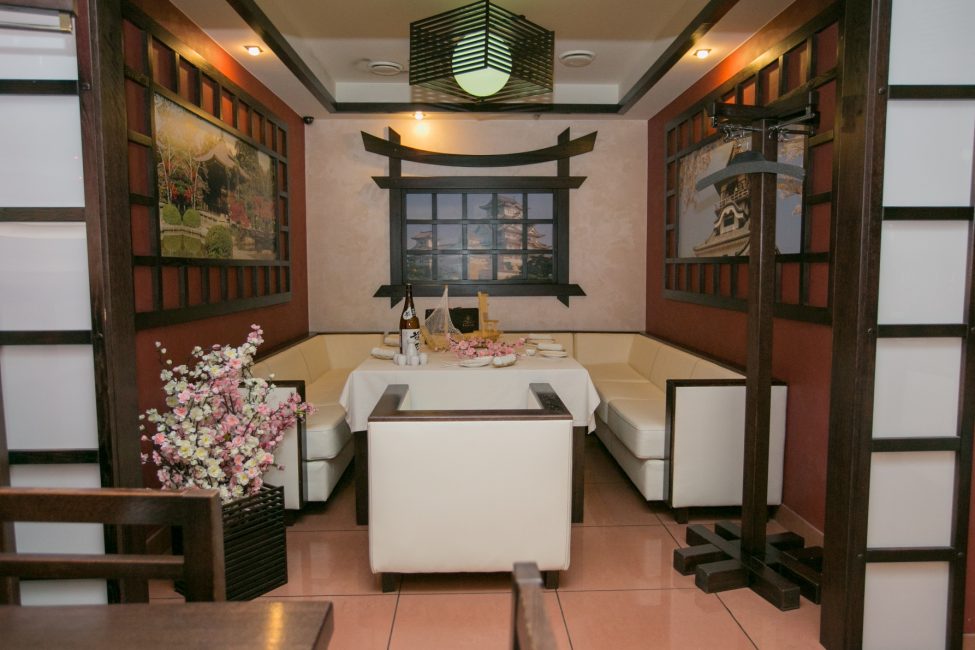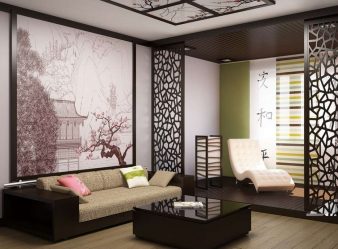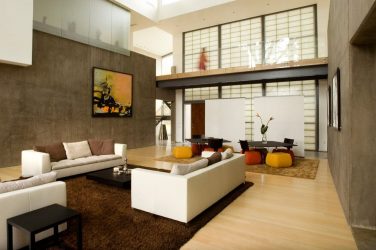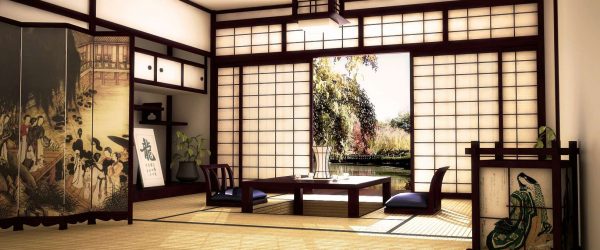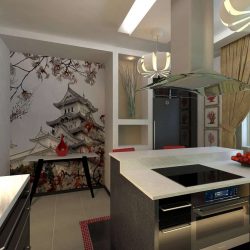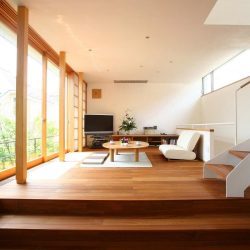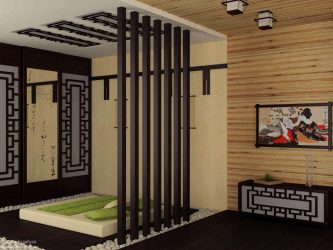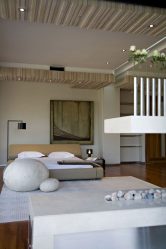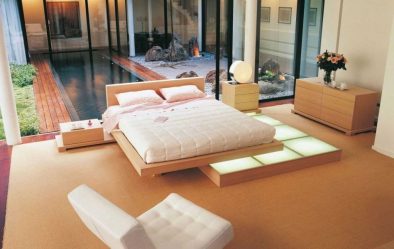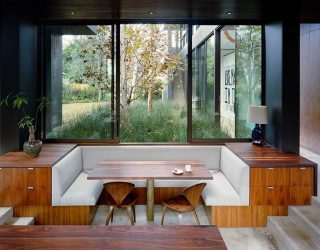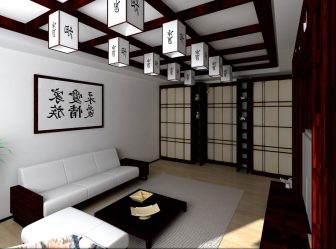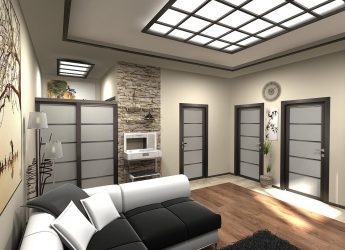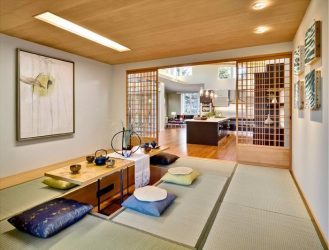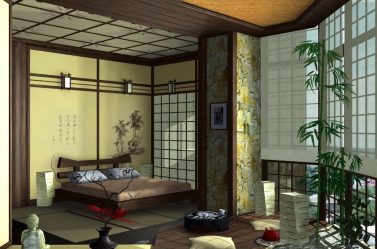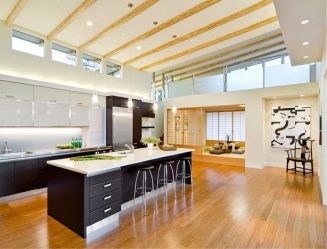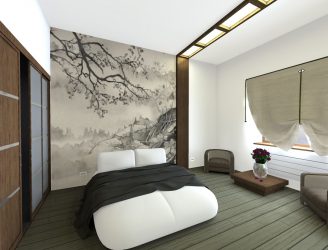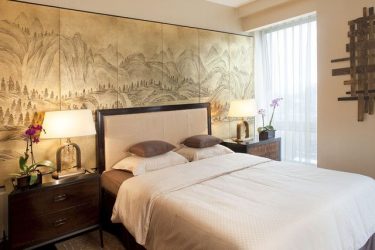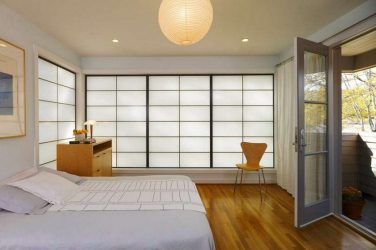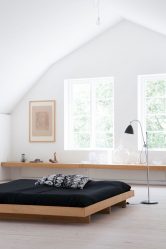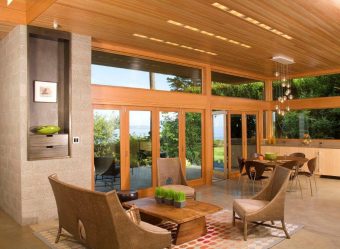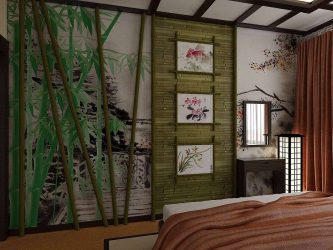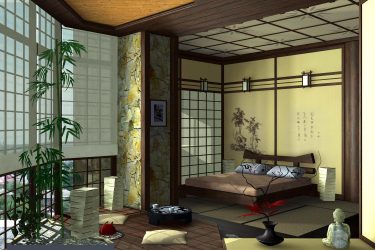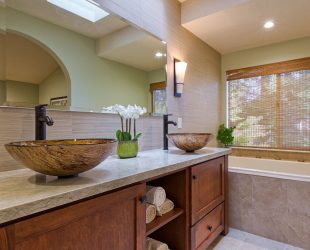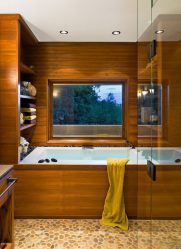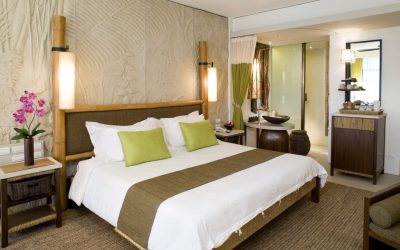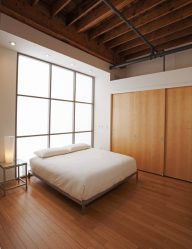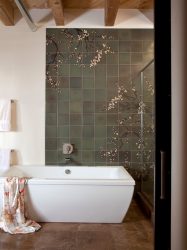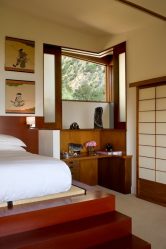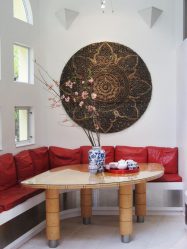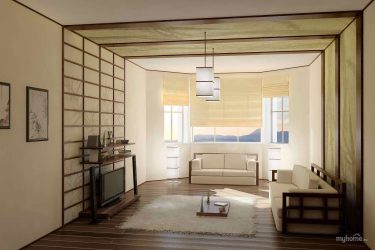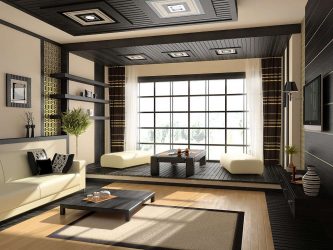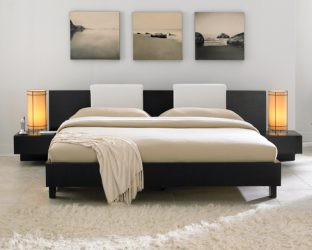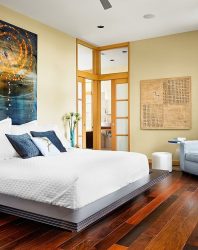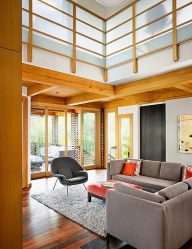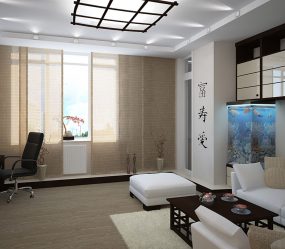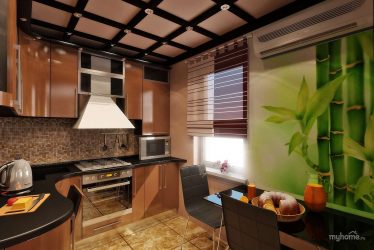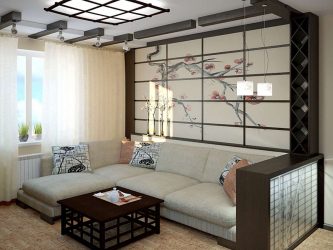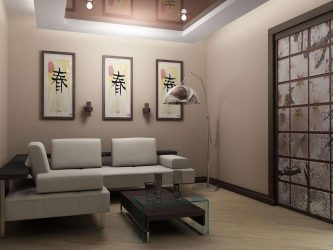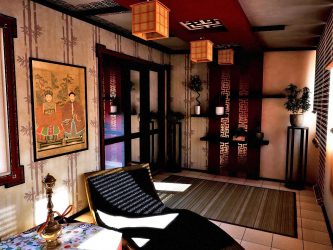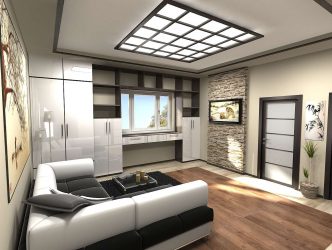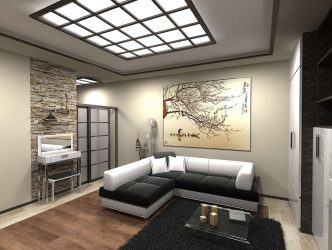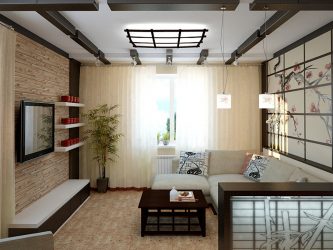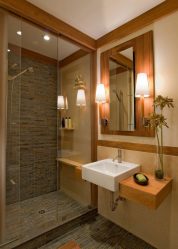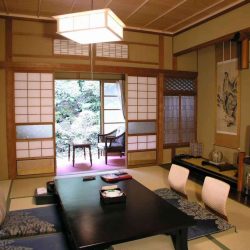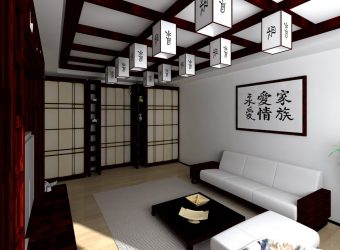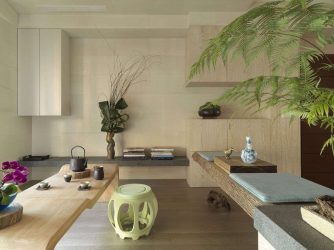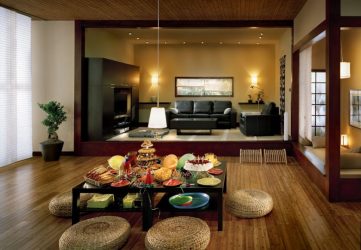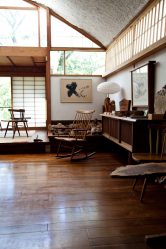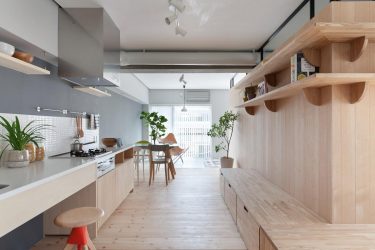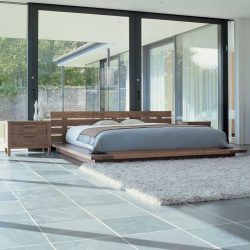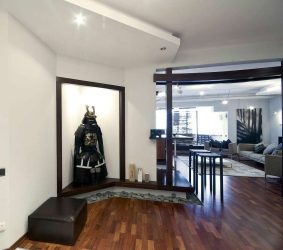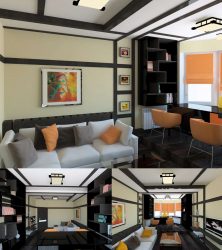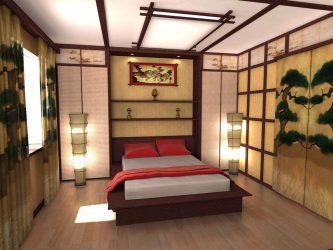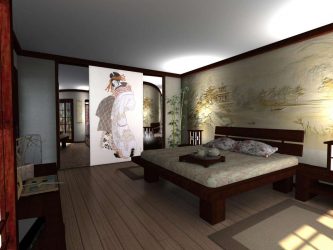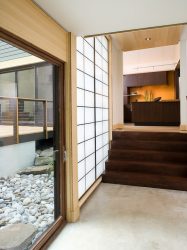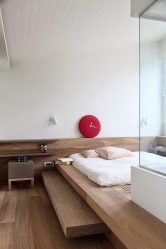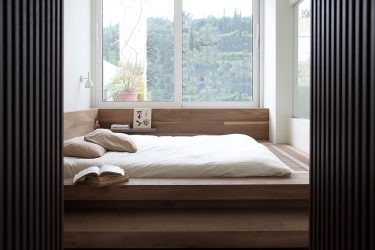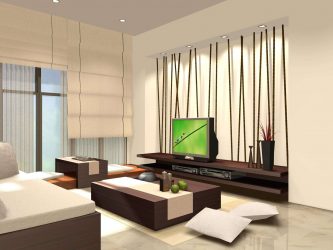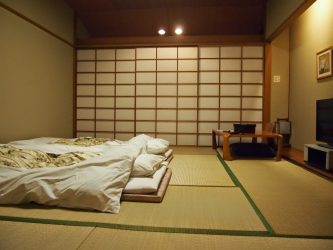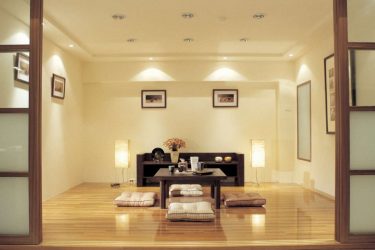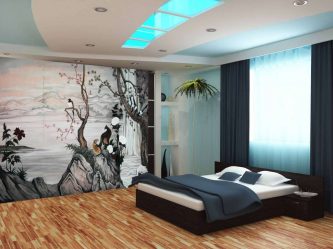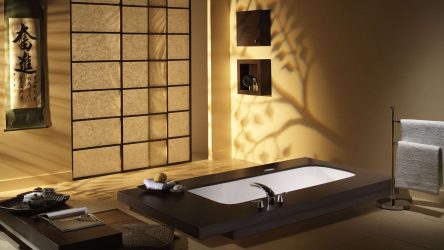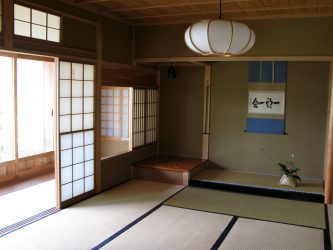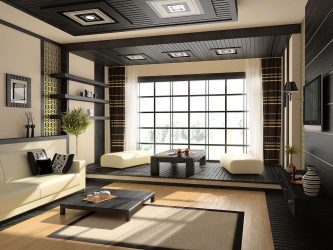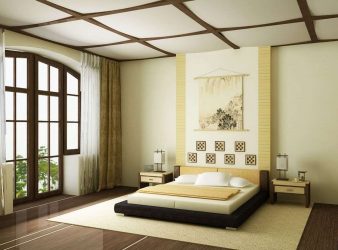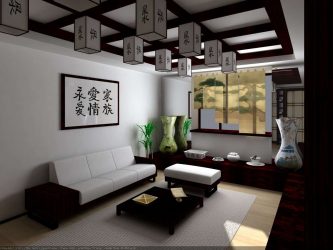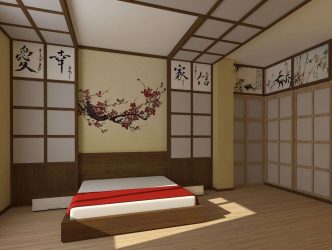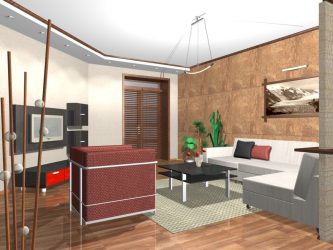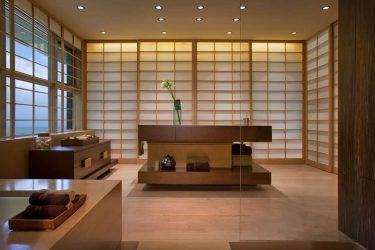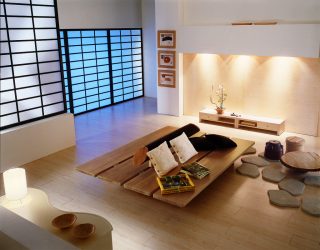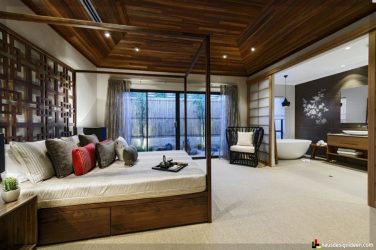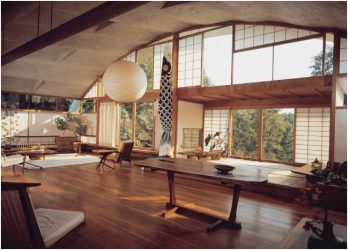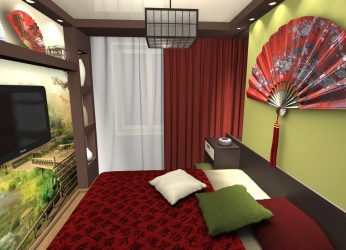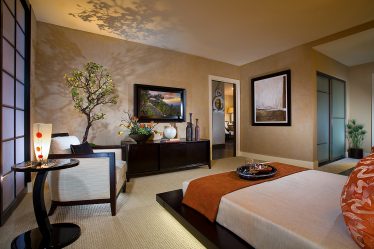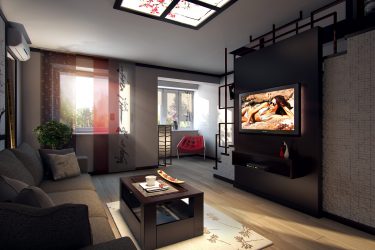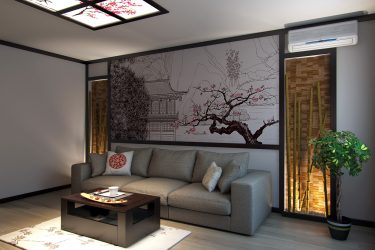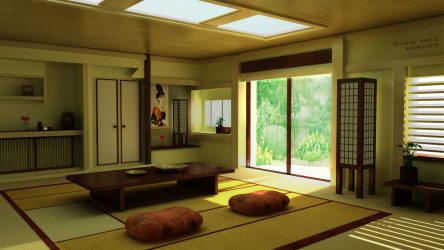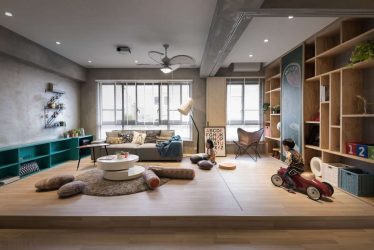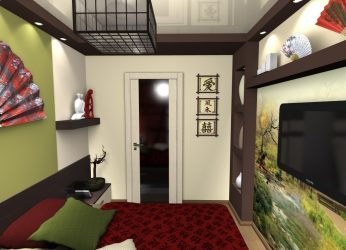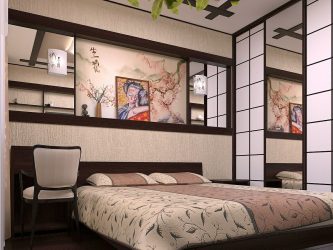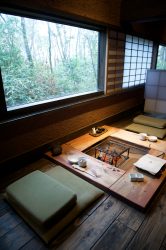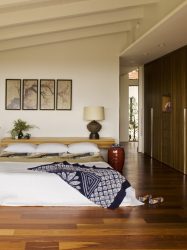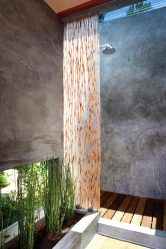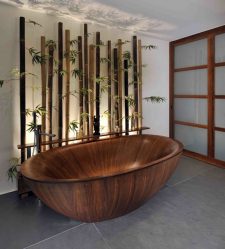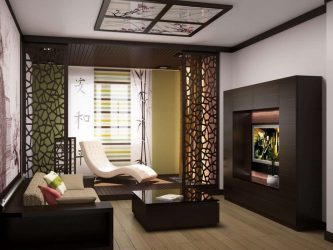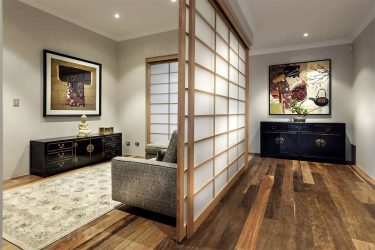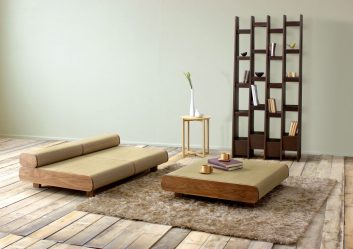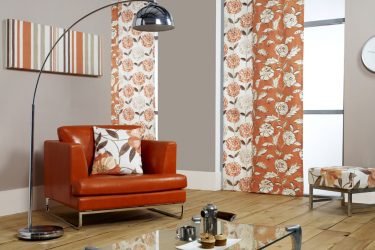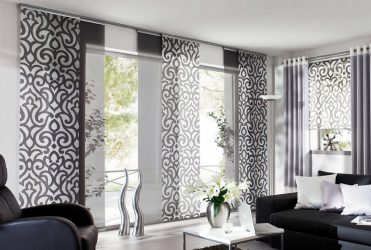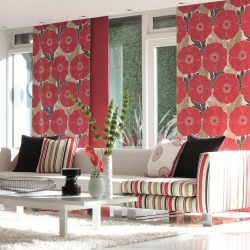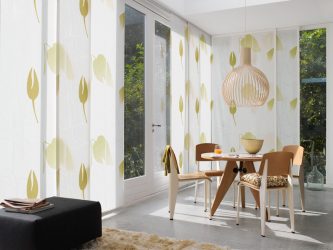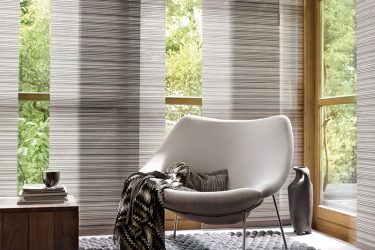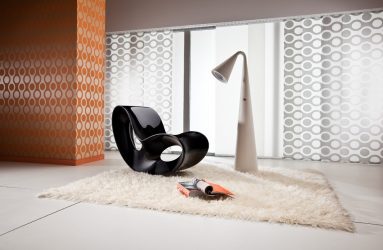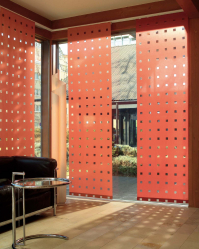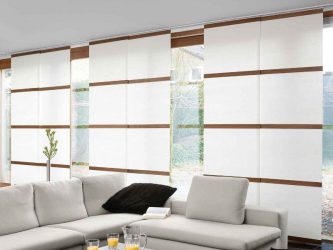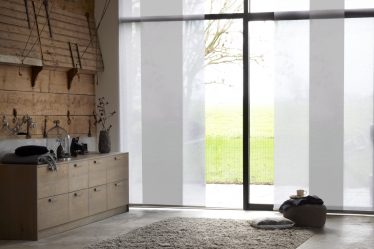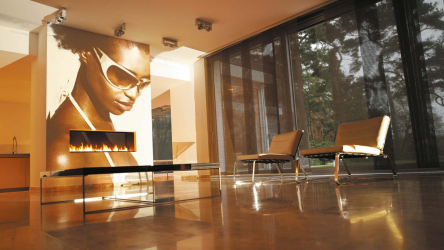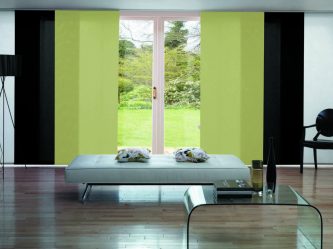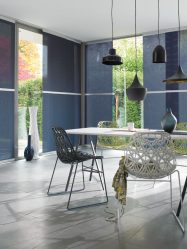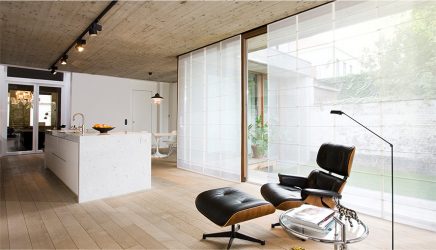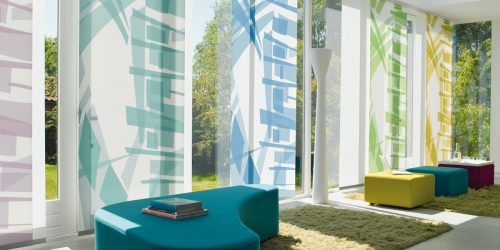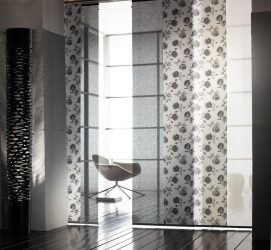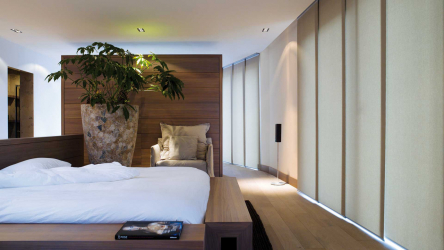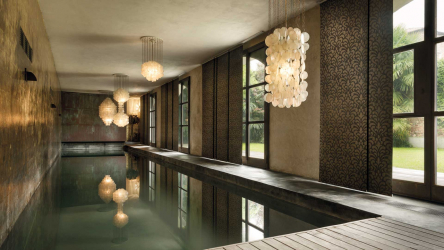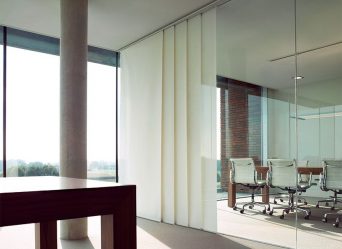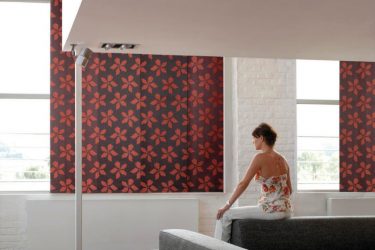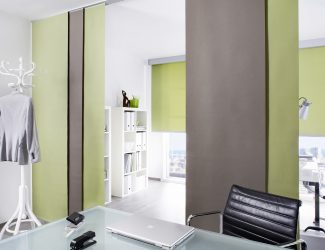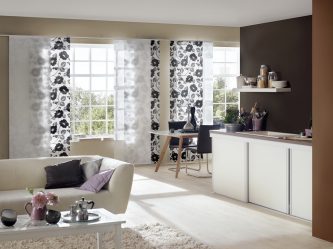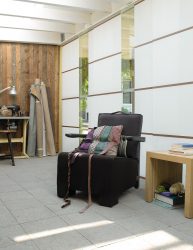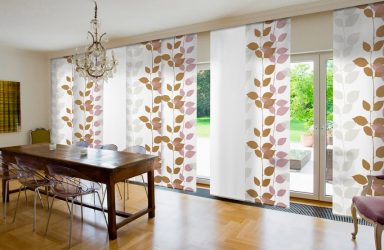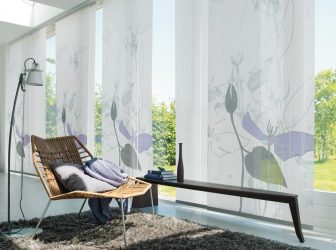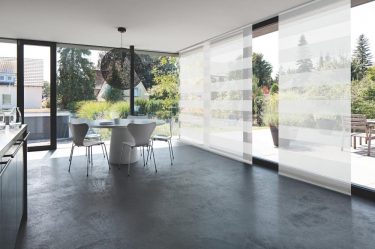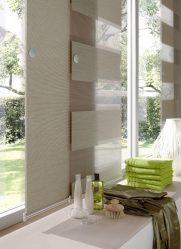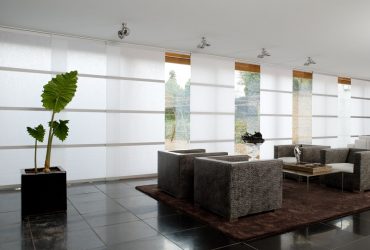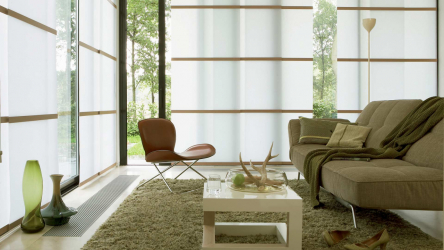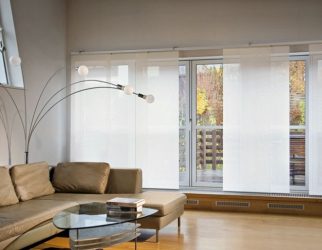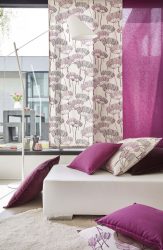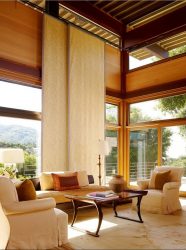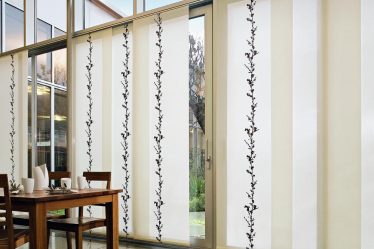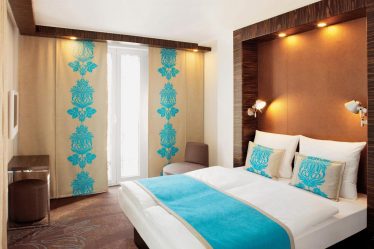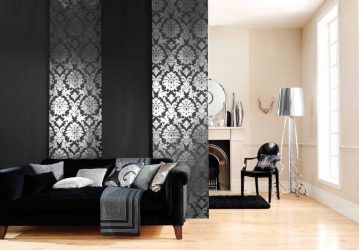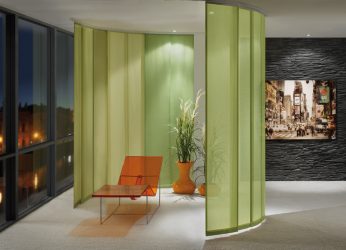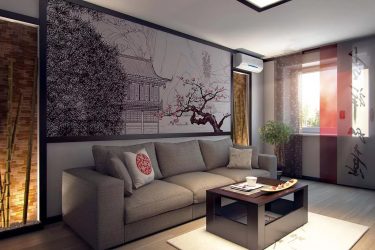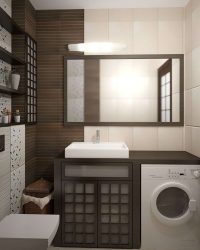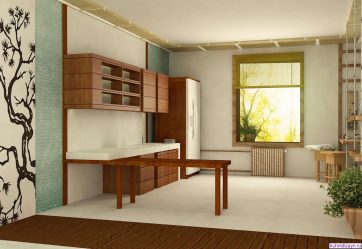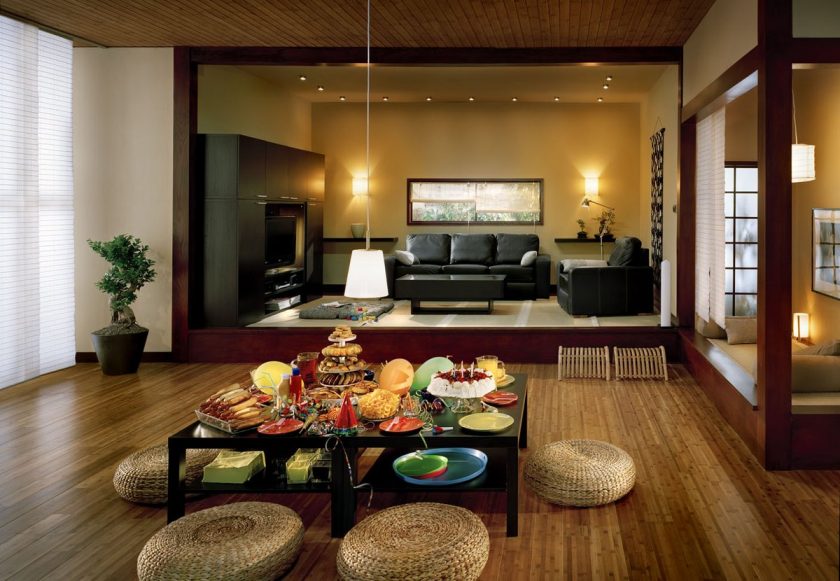
An apartment in Japanese style is a guarantee of comfort, tranquility and harmony in your home. At the same time exotic and discreet, Japanese style does not go out of fashion for many years. It is used not only in residential premises, but also in cafes and hotels. This style is based on harmony and unity with nature, self-knowledge through an understanding of the world, the use of natural materials.
Content:
Japan: the beginning began
Plunging into the basics of Japanese design, we discover the philosophy of the East, the perception of the world by people living so far from us, their traditions and mentality. For an Eastern person, thoughts and actions are important, but not petty vanity. All these requirements are transferred to housing, decorated in Japanese style.
Who would like and suit this style? Thoughtful calm people who appreciate the order in the house and the aesthetics of the surrounding interior.
return to menu ↑Style formation
As such, the Japanese style of home decoration dates back to the distant XVI-XVII centuries. After several centuries, it is still in demand and popular.
The following factors influenced its formation:
- frequent earthquakes;
- traditions of the people;
- small amount of minerals;
- densely populated Japan;
- climate.
Since the 16th century in Japan, there has been a trend towards home improvement with taste and in the spirit of tradition. Luxury gave way to higher values. The western approach to the design of apartments and their design in the land of the rising sun did not catch on.
The peculiarity of the territorial location of the country, frequent earthquakes and climate left their mark. In an area with an unstable seismic situation, quite often people had to rebuild houses after destruction. Easily assembled exterior wall structures and the lack of interior made it possible to simply restore the building.
return to menu ↑Free layout
The spaciousness should be felt even in a small dwelling. Economical use of free space requires a small amount of furniture, and especially accessories. According to the ancient Japanese tradition of interior walls and doors of the usual form in the house there.
This preserves the allocation of zones using various techniques:
- screens and other partitions;
- lighting;
- level floors, etc.
Interior today: are there any differences?
After several centuries, the style of the houses of the country of the rising sun has undergone some changes.
It reflected the events taking place in the world:
- technical progress;
- war, including World War II;
- scientific achievements.
All this has led to new opportunities for the design and construction of housing. Concrete, materials imitating wild a rock, tree etc.
Japanese Style Basics
Today ethnics is very popular, and the East - all the more. Deciding to arrange your apartment in the Japanese style, it is desirable to be guided by basic principles.
return to menu ↑Nature
The proximity of nature, respect for her and understanding form the basis of the creation of a Japanese home. Large windows and doorways should ideally have a view of the picturesque garden, fountains and lawns.
In the interior of a city apartment, the principles of unity with nature take the following form:
- aquarium with fish;
- bansai;
- bamboo in flower pots;
- pictures with views of nature.
Partitions
The separation between rooms, the separation of personal space in the common room and the allocation zones performed using partitions. For this is used treerice paperbamboo
The main trends in choosing furniture
Japanese-style furniture should be low. Wooden surfaces are smooth and concise. This applies to furniture legs, armrests, headboards, hinged shelves, etc.
return to menu ↑Color spectrum
Warm paints and monochrome surfaces in bright colors are what the Japanese have preferred since former times.
The most popular and actively used shades of the Japanese interior include the following:
- white;
- beige;
- cream tones;
- sand and so on
What about black and red? These colors are never introduced into the interior as primary. They are needed for emphasis and selection.
return to menu ↑Color setting the interior
Characteristic of Japanese traditions, the characteristic style is emphasized in three primary colors:
- black
- red;
- white
There can not be expressionless shades and vague combinations that "wreak havoc." Harmonious Japanese interior is clarity and order. And yet - it is a combination of bright clear color with surfaces from natural materials and natural tones.
The basis of the Japanese interior design is always made up of light soft shades of a beige-milk range. Less commonly can be used:
- bluish gray tones;
- shades of cherry blossoms;
- green.
Japanese style: environmental friendliness comes first
Conciseness and minimalism, which is peculiar to the Japanese style, is based on the use of natural materials. In former centuries, only readily available material was used to decorate their homes.
This includes:
- mat;
- bamboo;
- tile from stone;
- cane;
- tree;
- rice paper;
- natural silk.
At present, the rules of arrangement are not so strict. But the use of synthetic materials is also limited. We are talking about linoleum, plastic and similar things.
But the artificial materials are completely prohibited under the design of the Japanese interior..
Shoji dividers
Partitions between rooms, made in the Japanese style, give the apartment originality and emphasize the focus of design. They are mobile and light, as they are made from rice paper or bamboo.
This seemingly strange and impractical approach actually has a historical and practical rationale. Frequent earthquakes in the land of the rising sun taught the Japanese to build houses that easily survive difficult circumstances. And if necessary, they can even be easily replaced.
Screens - an optional, but very stylish element of modern Japanese design. If you need to fence off any zone of the room, then they will not find a better replacement.
return to menu ↑Furniture for contemplating the inner world
Do you want to relax and rest at home, enjoy calm and recuperate? Japanese design contributes to the rest of the city rush, noise and clarify the relationship.
The proximity to nature and land in the interpretation of the eastern design involves the use of solid furniture from natural materials. Squat objects should have stable, short, strong legs and a simple form.
Wood is a typical material for manufacturing. Valuable breeds can be replaced with needles. Even if all the furniture is very expensive, it should not “shout” about it. A connoisseur of quality things will always be able to understand that a thing is not simple. Another characteristic feature is the absence of wood carving and plastic inserts.
Acquisition of furnishings for the design of an apartment in the Japanese style can be done in two ways:
- Genuine Japanese stuff with a story.
- Collections currently on the market.
Furniture accessories also should not be catchy. Forged items, made very carefully, are acceptable as a means of underlining the texture of the base material.
What interior can we not do without in strict Japanese design?
Among them should be:
- the beds on low legs (they can be replaced with mattresses);
- squat tables for traditional tea parties;
- special mats or pillows near of the table;
- wardrobes with sliding doors, etc.
Engawa or traditional window?
Initially, Japanese homes were equipped with special sheds, which are called "Engawa". Such structures protected from rain flows and shaded from too bright sunlight.
Prints on the curtain canvases should strictly follow the canons of the Japanese style:
- sakura branches;
- bamboo shoots;
- bright birds;
- Japanese landscapes;
- hieroglyphs;
- fans;
- Geisha in traditional attire.
For shading practiced roll and roman blinds. The smoother and laconic curtains, the more precise the matching style.
Walls
In the design of the walls in the Japanese interior, as well as other surfaces, it is important to follow the rule of using natural materials. The combination of several materials looks impressive. What to choose?
Such materials are suitable:
Furniture in the Japanese design of the home is very small and it is low. Its number and location should be considered when selecting materials for walls.
Wallpaper
Oriental motifs on the wallpaper in the interior of the apartments affect the perception of the entire room. They are the backdrop for furniture, create the necessary accents and emphasize authenticity.
Wallpapers can be combined with other natural materials:
- a tree;
- bamboo and so on
If plain wallpaper is preferable, then one of their walls can be decorated with photo wallpapers with a picture, for example, of a cherry tree branch. Such wallpapers can create the effect of a photograph, a view of Mount Fuji, or other typical Japanese landscapes.
National motifs on the walls emphasize the style of the interior, bring notes of unusual and unique. This allows you to create an interior that is not like the others.
It will be interesting to you:
Wallpapers produced in Japan
Separately, mention should be made of wallpaper produced in Japan. Created on the basis of natural materials, they do not pose a threat to health. Raw materials for them are: bamboo, jute, etc.
In addition to aesthetics, these wallpapers have other useful properties:
- blocking possible evaporation of formaldehyde from the walls;
- eliminate the spread of cigarette odors;
- universal in design;
- refractory;
- give good sound insulation;
- allow you to hide the flaws of the walls;
- environmentally friendly;
- durable;
- have antifungal properties.
Gender: which coverage is better?
In the old days such materials were used for flooring:
- stone tile;
- tree;
- pebbles.
The comfort and convenience is created by the rugs made of threads, a rod or other natural material.
At the moment, the choice of materials is wider:
- ceramic tiles;
- parquet;
- laminate;
- natural wood;
- bulk floor.
Zoning can be performed using a coating. Also for these purposes multilevel constructions are used.
return to menu ↑Ceiling: form and content
Ceiling in the Japanese style in its form should be consistent with the overall focus. The clear shape (triangle, rectangle) is emphasized by color, material and design.
Finishing in this case plays an important role. Wood beams, painting, panels.
Fabric, creating comfort
Textiles in the design should follow the same basic rule: naturalness and simplicity. In the Japanese interior, it is needed on the windows, in places for sitting near the table, for resting areas, in the bedroom, for screens.
Of the materials most preferred:
- silk;
- linen;
- cotton;
- blended fabric.
Prints can depict:
- blossoming cherry tree branch;
- hieroglyphs;
- animals;
- Mount Fuji, etc.
Accessories: we place accents
The Japanese interior is a harmoniously organized space. Room design must be balanced and verified. All decorative elements should be contrasted in relation to the main background, but carefully thought out.
Japanese-style accents can be created using these elements:
Lighting, emphasizing oriental flavor
Lighting in Japanese homes is given special attention. Light must be diffused, emanating from several sources in each room. For fixtures You can pick up lampshades made of bamboo or thin rice paper.
Interiors of rooms
Let us consider in more detail the interior in each room. What and how best to use, and what is really not necessary.
return to menu ↑Bedroom
Japanese style lounge is an organic and original solution. The selection of materials and furniture begins with determining the dominant color. In addition to it, it will be possible to choose several harmoniously combined shades.
For the bedroom will suit these colors:
Soft diffused light is created using lampshades made from paper, frosted glass, cloth.
The design of the bedroom can be guided by the following recommendations:
- Use wallpaper (including bamboo) and photo wallpaper with ethnic prints.
- Wooden panels.
- Plain fabrics on the walls.
- Minimalistic bedside bedside tables.
- Placement only necessary furniture. Nothing extra.
- Built cupboard with sliding doors.
- Screen curtains, the shape of which is emphasized by weighting in the lower and upper parts.
- False ceiling, frosted glass inserts are possible, creating a beautiful effect of "moonlit sky".
- Built-in lights.
Expressiveness and conciseness attached to the room accessories. They should not be much. These can be paintings, fans on the walls, bonsai in pots, dolls in national costumes, etc. Bright emphasis can be placed on the design of the bed, if you use a bedspread with hieroglyphs or red pillows.
Children's
Japanese style prefers light colors, which is a plus when making a child’s room. Natural shades and natural materials allow not only to emphasize the style, but also to create an eco-friendly healthy interior.
Selection of furniture is desirable to implement, adhering to such principles:
- comfortable comfortable bed, which is desirable to arrange in the central part of the room;
- the workplace must be functional and well lit;
- screen - to separate the recreation area from the game;
- wardrobe with compartment doors, which can be arranged as built-in;
- The shelves are wooden, but light enough.
Accessories depend on the gender and age of the child. Preference should be given to those that are made of natural materials and emphasize the style: national dolls, figurines, etc.
return to menu ↑Living room
This room is central in the house, designed not only to relax and socialize family members, but also to meet with friends and business partners. Therefore, the design should be taken into account all the specifics. A neat, bright room with a minimum set of objects and unusual styling will not leave guests indifferent.
Natural light shades still prevail:
- beige tones;
- white;
- ivory;
- natural shades of wood;
- Gray.
For studio apartments living area can be organized on a low podium. Additional highlighting is created by color (floor, walls, ceiling, furniture), organization of lighting.
High comfortable chairs and bulky sofas should be replaced by simple and more austere in form and design, which may seem uncomfortable. Storage systems can be built-in, equipped with compartment doors. For those who have their own library, we can recommend to organize the storage of literature in artificial niches, organized directly in the walls.
The decor of the living room should be discreet and strict.. Here can not be placed family Photo and memorable souvenirs from places of rest. Neutrality is one of the basic requirements.For decoration, you can use the paintings on the walls, antique vases, bamboo.
return to menu ↑Bathroom
The conciseness inherent in all design, should be traced in the design of the bathroom. Traditional bath - wooden, hollowed out and processed according to a special technology.
With respect to showers, the same minimalism is observed:
- simple glass partitions;
- in the floor - drain hole;
- simple organization of taps and showers.
In the bathroom, it is quite acceptable to use photo wallpapers with images of thermal springs, bamboo, sakura, landscapes characteristic of Japan.. It is only necessary to take into account that such wallpaper must be moisture-resistant, designed for sticking in rooms with high humidity.
return to menu ↑Entrance hall
The first impression of housing begins to form in the hallway. The color scheme is pleasant for the eyes and natural. This is a wide range of brown shades, gray. Additionally - bright colors in the form of accents. The organization of a small space in the Japanese style requires a compact used items. Suitable for decoration floor vase, a picture in a simple frame, the image of hieroglyphs.
Lush ottomans and elegant stools are better to be replaced by modest benches made of wood or bamboo. Such piece of furniture will become in itself an ornament of a hall. If soft upholstery is preferred, then linen, cotton, silk or suede can be used.
As the material for the floor in the Japanese style can be used wood or high-quality laminate. It is interesting and unusual in this case will look made on a bamboo base.
Kitchen
The Japanese-style kitchen requires wooden furniture and clear geometric shapes. Furniture set must have strict facades devoid of decorations. Only inserts in frosted glass are allowed. Handles desirable to choose hidden.
The selection of the dining table is based on the size of the room. If there is a lot of space, the table is placed in the center of the room, preferring a rather massive model.
With a lack of free space, you can place a lighter structure. Chairs should be solid, streamlined.
Kitchen lighting should be sufficient, but diffused. Lighting fixtures - a simple form (sphere, cube, etc.).
In addition to the frosted glass for the manufacture of ceiling lamps in the Japanese style can be used such material:
- rice paper;
- jute;
- tree;
- branches;
- straw.
Kitchen decor is minimal. Suppose a scroll with hieroglyphs on the wall, a vase in a niche, ikebana, ethnic engraving. An additional decoration of the Japanese home are living plants:
- bamboo;
- orchids;
- bonsai
Kitchenware placed on stands and open shelves must support the surroundings of the East. It is advisable to select all items in the Japanese style, in harmony with each other and with the overall design.
Japanese style
Create a beautiful design
